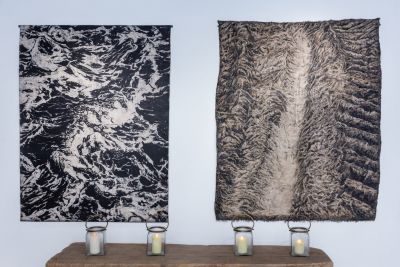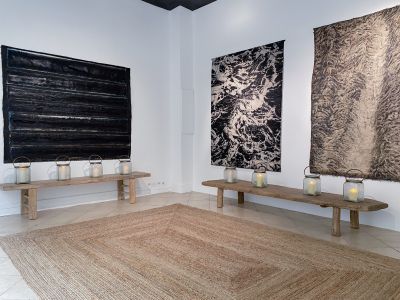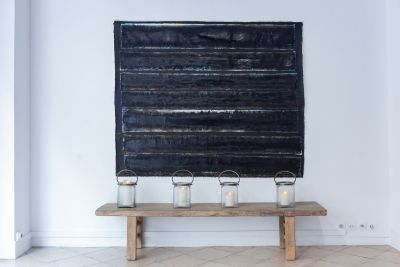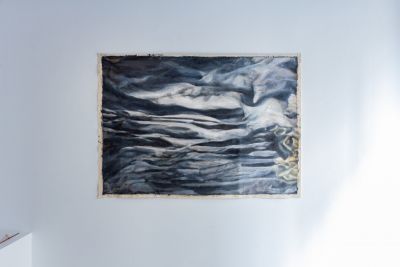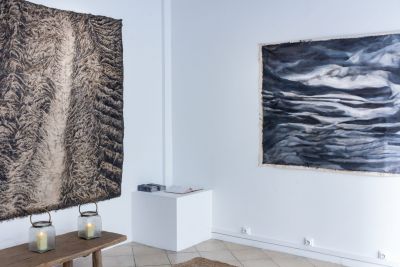Aurélie Deguest has an almost Donjuanesque relationship with painting. She sometimes feels like painting everything that comes into view. This is undoubtedly the protean nature of her gifts as a painter, which have enabled her to conquer with surprising ease all the techniques of this art, in order to honor most of its motifs and styles.
She is as ready to execute realistic portraits imbued with a poetic spirituality, as in her series “Femmes en prière” presented at the JUSTLX fair in 2022, as she is to assert a fully expressionist painting style, as in her latest solo exhibition Faces, at Loo & Lou Gallery in 2015. In addition to her mastery of drawing and color, the artist now extends her skill in this current series to the exploration of a matierist abstraction, the fruit of her new experiments with surfaces, of which she offers a sumptuous variation of textural effects and rhythm.
Far more than the blank canvas, it's the imposing variety of all her pictorial arrangements that can arouse in her a form of intranquil vertigo: what to paint now? Since Deleuze, we know that “it would be a mistake to believe that the painter works on a blank, white surface. The entire surface is virtually invested with all kinds of clichés that must be broken”.
The artist is thus committed to a kind of pictorial reduction dear to the proponents of abstract expressionism, in order to return to the very object of his passion: painting.
The four works on show in the Loo & Lou Gallery studio are a radical rethinking of her approach: here, no frame, no title, no calligraphy, no space, no time, no object, no subject, no explicit drawing... Aurélie Deguest succeeds in forcing out of the surface of the canvas that which is not specific to painting alone, thus isolating the work from all external reference.
His paintings do not offer a distanced, illustrative or even landscape view of the aquatic element, but seem to plunge the viewer's gaze into the elusive viscosity of deep water. Hence the Japanese character of some of his works, which may also evoke the spirit of Chinese painting, which philosopher François Cheng once said
The philosopher François Cheng once said that Chinese painting “grasps the world beyond its distinctive features and in its essential transition”.
To ward off the emptiness of a uniformly white background, she covers her canvas with a preparatory weft, sometimes using strips of black canvas to give a visual rhythm to her future composition.
At once meditative and materialistic, each composition can suggest the surface of water in the fluidity of its ceaseless surf, the imprint of a pachyderm's skin or the moult of a reptile, the telluric folds of a concatenation of cooled lava. The epidermis of the earth and the memory of the stars, the canvas also takes on the appearance of a bewitched tapestry, enveloping in its infinite folds a layer of canvas mixed with the thickness of dried paint.
The surface of the painting becomes embossed with the crevices of a stellar landscape, criss-crossed by eruptive ridges and crevices.
By abandoning the idea of framing and stretching his canvases on a stretcher, the artist finally frees himself from the symbolism of an over-codified painting, still in the grip of an image-making function too bloodless for his taste.
Hence her need, perhaps, to confront this “night of logos”, of which the poet Francis Ponge spoke, by establishing black as the dominant color in her works, which she subtly balances with counterpoints of earthy, bluish white, evoking both the genesis of the world and its apocalypse.
The nocturnal tone of Aurèlie Deguest's canvases sometimes hints at evanescent forms, like the specter of Ophelia. This painting, then, seems to play out in the obscure in-between of matter and dream, presence and absence, plunging its wandering shadows into the depths of the waters of the Styx, which legend has it carried departed souls to the realm of the dead.
In choosing to set her painting in the nocturnal atmosphere, the painter is surely aware that night is also that pathos conducive to all rebirths. Novalis called night the “place of revelations” (Offenbarungen), in which the germ works in the maternal depths of the earth, preparing for its advent into the light.
Doesn't the painter transform black into a luminous color, creating a sumptuous variation of light effects through the matte and gloss of her outrenoirs? To this end, the paint is often enhanced with gloss to perfect the surfaces, which she then smoothes with a knife, helping to turn the canvas into a vibrant ode to sublimated material effects.
In this way, the artist pays particular attention to the textures of her works, preferring to use coarse jute canvas or thick draperies as supports for her paintings, to reinforce their tactile character? Playing on oppositions of night/light, diaphanous/obscure, smooth/rough, optical/haptic... Aurélie Deguest takes up Bachelard's advice to the poet's imagination: work with substances that are the most contrasting and apt to awaken poetic reverie. The artist invites viewers to let their gaze wander over the surfaces of her canvases, perhaps rediscovering those lost sensations that we all bring with us when we are born.
- Philippe Godin, art critic
